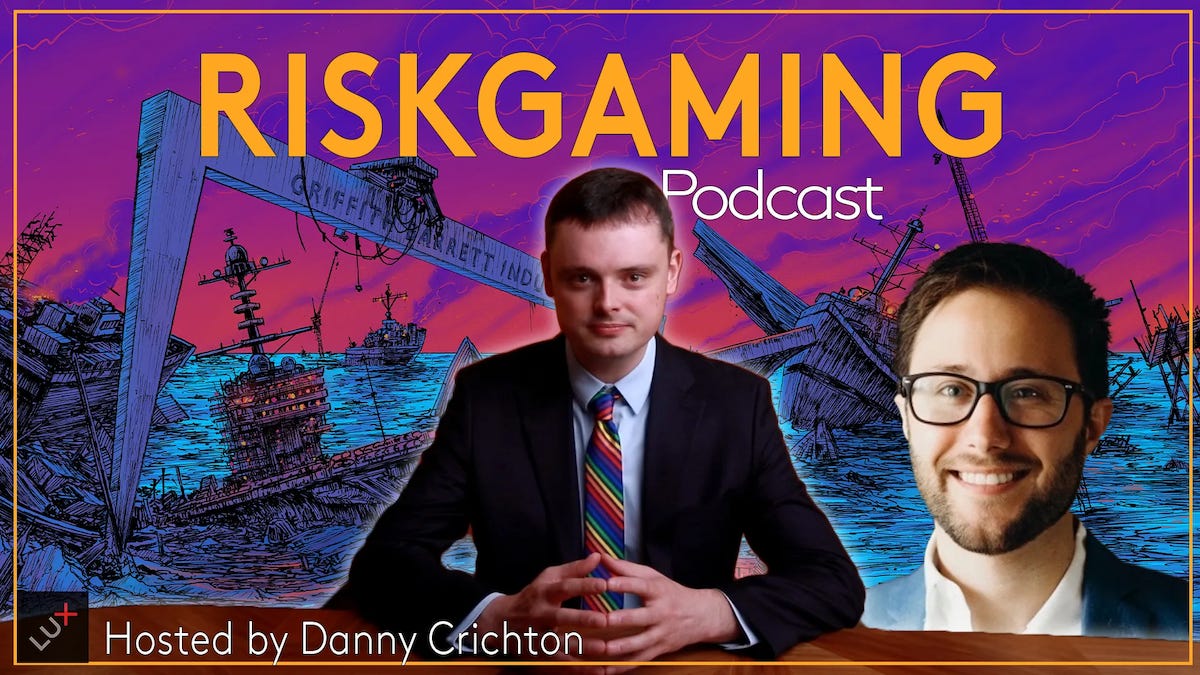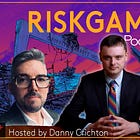The challenges of complex risks in game design
Randy Lubin on play, learning, and AI and the future of games
Building great Riskgaming scenarios is far more of an art than science. The designer needs to understand the players — what they know and what they don’t — and then carefully construct a landscape of decisions that has fidelity to the real world while not being overwhelming. Parsimony is key, and that means a designer really has to grok the fundamentals of the issue under hand to be able to offer the best experience.
That’s where Randy Lubin shines. Through his studio Leveraged Play, he has designed a whole suite of fun and profound policy simulations, focusing on the intricacies between tech and culture. Now, he’s also designing a new Riskgaming scenario for Lux, focused on AI, automation and the future of cities, exploring policy issues like employment and housing.
Today, I talk to Randy about his design process, what’s going on with his upcoming scenario, how AI is changing the future of game design, and a bit about his game design community Foresight Games.
This interview has been edited for length and clarity. To hear more of the conversation, please subscribe to our Riskgaming podcast.
Danny Crichton:
So Randy, you’re a long-time game designer. I feel like you've been exploring what you call “foresight games,” these unique experiences that allow people to predict and explore the future, for at least a decade.
Randy Lubin:
Yeah, Foresight Games probably started in about 2017, 2018. Like many of us, I love playing games, started designing games that I wanted to play but didn't yet exist, and then I had a cool opportunity with some friends who were running Scout AI to make a “serious game” that explored how technology was going to shape future elections. So we made this game, Machine Learning President.
I didn't know anything was going to come of it, but it stoked a ton of inbound interest in creating games for all sorts of purposes. And over the past decade, I've spent anywhere from a hundred percent of my time to a smaller portion of my time doing serious game design.
Danny Crichton:
How do you find the topics for your games?
Randy Lubin:
It's very different from the consumer game side versus the serious game side. On the serious game side, it's all from clients. It's very much what problem are clients trying to solve? How do we find a game that helps accomplish those goals?
On the consumer side, it's really about what tickles me. What is an interesting frontier to push on? What is a topic that hasn't been explored through games? What is a set of mechanics that hasn't been touched, or a set of player dynamics I want to foster?
Danny Crichton:
One of the things we're trying to do with any sort of game is to bring an element of play. Even though you're dealing with sometimes very, very intense and serious issues, play opens up the space for people to experience something new.
Play can be so, so powerful. It gives folks an alibi to set aside some of their preconceived notions.
Randy Lubin:
Play can be so, so powerful. It gives folks an alibi to set aside some of their preconceived notions. As soon as you give somebody a role and a goal, in most situations, they're going to want to accomplish that goal and they're going to want to develop an intuition for what actions are going to benefit them. It also gives them cover to say things that, in an institutional context, they might not have the political support to say. And that can be really great for getting less orthodox beliefs, opinions, scenarios on the table.
Danny Crichton:
When we do riskgaming, as we bring people from science, business, policy all together, the most important thing we've found is getting everyone to play a role they don’t play in real life. They know their own life, they know the rules. And oftentimes people get very, very focused on details. They think, "Well, this budget is actually 1.02 trillion, not 1 trillion, this changes everything." And you're like, "Eh." But then if you get people to play other roles, suddenly they realize, for example, they don’t even know how congress functions. It's extremely useful for people to play things that they are not familiar with.
Randy Lubin:
Yes, and also just because it's great for helping them develop more intuition and to understand at least some of the superficial incentives a given type of role faces. I found that in a lot of these applied games, you can get people walking out saying, "Oh my goodness, I didn't understand why this type of actor was acting the way they were, and now it makes total sense."
Danny Crichton:
So you have all these ideas and scenarios, but the challenge — and 95% of game development — is the mechanism. How do you connect all the dots together? How do you figure out what characters should be played, which characters shouldn't be played? I call it “scoping parsimony.” Games can be wildly large and you can't focus on anything or they can be too small and very, very boring.
So I'm curious: Let's say you have a new scenario, a new storyline, how do you start to explore that space and identify exactly how a game should be structured?
Randy Lubin:
I always start with being crystal clear about goals and constraints. If it's for a client, if there are a lot of stakeholders involved, I make sure to talk to all of them, really include all of their perspectives, and because there are going to be trade-offs along the way, talk through how they prioritize those?
And the goals can be different from what does the sponsor want to get out of it versus what do we want players to get out of it? Some games are much more about delivering insights to players, some are about generating insights to facilitators and sponsors, and sometimes it's a mix. It's often a mix.
And so once we’re crystal clear on the goals and constraints, the next step is about generating lots and lots of ideas. Those ideas can hit a bunch of different categories. So a lot of mechanical ideas. Sometimes it's less about the specific mechanics than key moments like, "Oh wow, I really want a powerful interaction where two characters come head-to-head for negotiation.” Also there are ideas about the aha moments we want to have, or the types of insights we want surfaced in the debrief.
I usually then jump to a stage-gate approach, which comes from product development and manufacturing. What it means is taking multiple ideas through the process in parallel, and as you go, continuing to refine them, cull down and remix.
What I've found is that having these very different candidates that ultimately get to playstorming or playtesting does a few things. One, if you have a bunch of stakeholders or collaborators, it allows folks who are not game designers to still be able to express their preferences. It also helps expose preferences that weren't expressed upfront with goals and constraints. And it’s also just so good for creating other ideas to remix. Because you might end up killing an idea at the high level, but then using some insight from it later on. So I really like this process where you just keep refining and refining.
I mentioned a term: “playstorming.” It’s something I really love doing both on the consumer side and on the more applied or serious side. Oftentimes, the first flavor of playstorming is just with the collaborators, where you talk through the whole game and think about what players might do at certain points. What would happen if we changed the round structure or modified the incentives. Just by talking through the game from beginning to end, you can immediately see that you may not have designed for a whole set of edge cases or that it isn’t clear what a player would want to do.
And then, of course, the next jump from there is actual playtesting, whether it's a full playtest of the game or you just grab a few players and do a small portion of it. You learn so much by having contact with reality, so the faster you get there the better.
Danny Crichton:
I’m curious about the balance between consumer games that are very story-driven — meaning it's very directive, I'm trying to guide you to a certain place — and the serious side, where the direction is a little bit more open, a little bit more of an emergent set of properties.
Something I struggle with in designing games is the degree to which I want to control things. Am I the aggressive dungeon master who's like, "No, no, actually all roads are closed and the only road available is this one at the top of the mountain”? Or do I lean into the open play model?
I'm thinking of Hampton at the Crossroads, the first game we designed. We played a month or two ago, and everyone just started cooperating in a way that made no sense. They ignored all the things they were supposed to disagree about to collaborate as one harmonious group.
How much you want to direct folks?
Randy Lubin:
So it depends a lot on the goals and constraints set up in the front. Oftentimes, I like giving folks as much expressive space as I can, as long as it doesn't defy those learning goals and objectives. And there are lots of ways that you can try and have both. Maybe the player has a lot of local agency in terms of the decisions they're making, but in terms of how that intersects with everybody else's decisions, then I put my thumb on the scale.
"Random events" are sometimes random or sometimes very pre-selected. And I can very strongly shape some incentives. And again, this goes back to the objectives. For the types of games I do, if it's really about generating insights for the organizer or the sponsor, it tends to be more in the open-ended direction. As long as you're getting the high-level goals and incentives right, if players go really imaginative, that's usually a feature, not a bug. And on the other end, if the goal is about really delivering a few very specific insights to the players, then the game is more closed.
Danny Crichton:
I always want people to feel like they really are the character, and in most cases you have a lot of flexibility in real life. Obviously that's hard to translate into a game.
But when you think about iteration, the playstorming and playtests, how do you balance between realism and game play? This is something I struggle with. All the games we do are sort of real-life scenarios, and you want the experience to be good, but some real-life characters are going to lose. Some players are in a tragic role.
But here’s the challenge: I want everyone to have a shot at winning. I'm thinking of our China electric vehicle game. The mayors in that game just don't have much of a shot, and that's because it’s accurate to real life politics.
Randy Lubin:
I think that dynamic is a key thing to be aware of and to be very intentional about. But I often find that balance really doesn't matter as much as making sure people are getting the insights they need.
More important than winning, though, is whether all the players are going on an interesting journey. Do they have interesting decisions to make every step along the way?
That being said, I think there are ways to calibrate. So in the mayor example, it could be that they're graded on a very different scale. So it's not whether the mayor triumphed relative to the big American automotive conglomerate, it's how they did relative to baseline expectations for a mayor.
Even more important, though, is whether all the players are going on an interesting journey. Do they have interesting decisions to make every step along the way, and are there clear affordances for how they might want to accomplish their goals?
Danny Crichton:
Here’s another big challenge: Most of our tabletop games are two to three hours. People come up with an original strategy in the first 20 or 25 minutes.
And then what ends up happening is, even though the game has changed and they should be adapting their strategy, they just keep doubling down. And I have really struggled with how to get folks to say, "Look, it's another year, it's a new scene, stuff has changed. You have to throw away what you had before and move on to something else.” But loss aversion is very, very real, and I've never been able to solve it.
Randy Lubin:
It's a thorny problem, and I think loss aversion is a big part of it. Depending on the game, one contributing factor could end up being just how clear feedback loop signals are. So one of the things you can do is make it clear if their strategy failed, how exactly it failed. It wasn't just a bad role of the die, it was because of a different coalition that formed or different incentives at play. I think that's a fundamentally hard thing to do, though.
One thing I'll do in some of my games is have a kind of top of the news segment where, maybe we've jumped forward months, maybe it's a year, and we capture what's in the zeitgeist. Some of that's going to be very relevant to play, and some of it's just going to be flavor. But it's just to give a sense that time is moving forward, context is changing. And in a game with totally open-ended interventions, it's also a way to just give people fodder to be creative.
Danny Crichton:
Let’s move on to the learning portion, and obviously that's one of the big objectives across all these games. The classic model, and I'm thinking Pentagon wargaming, is you play the game and then you go through a debriefing session at the end. But I’m curious how you integrate some of the learning into the game itself.
You could do checkpoints and take people out of the game experience, but I don't particularly like that. I think it's very disruptive and it kind of breaks the flow. But at the same time, and this kind of relates to this idea of people getting into ruts, but I see these moments where I'm like, "God, I need you to get this insight now." How do you think about helping people learn in your games? Do you have techniques?
Randy Lubin:
I have definitely done debriefs at the end. And I’m a firm believer in spending as much energy thinking about debrief as you do about the game itself. But yes, there are a lot of cool techniques. One is from the Nordic LARP scene called Bird-in-Ear.
So Bird-in-Ear is this technique where the facilitator goes up to a player who's in character and whispers something in their ear, and it might be a suggestion or it might be a little bit of inner monologue, but it's to provoke a specific type of action. So maybe a facilitator goes up to a player and says, "so your CMO comes to you and says, 'Hey, there's this interesting opportunity to do marketing. We see our competitors are doing it, it seems to be working." I think those types of interventions can work quite well.
Another way of showing it, so that key insights are shared, is to work it into a top-of-the-news round update. And don’t just say, "Oh, competitor A has really leapt ahead in terms of market share," and leave it at that. Say, "They've leapt ahead in terms of market share, analysts are saying it's due to their heavy investments in marketing."
Danny Crichton:
Let me pivot to one more thing. You're a longtime game designer, but that's not the only thing you do. You’ve also done a lot to build the Foresight Games community. So before we close out, I'd love to talk a little bit about the community you've been building over the last couple of years.
Randy Lubin:
Yeah, absolutely. And if you're even a little bit curious, please go to foresight.games to check us out.
I created this community because… it's interesting. We've talked a little bit about how there are war games on the defense side of things dating back to the Prussians in the mid-1800s. These have flourished and had major impacts on actual military strategy.
But we've seen it a lot less outside of a military context, and I think there's so much potential there. I also think we're still at the early days of figuring out what types of patterns work in what situations, what are some of the really thorny design issues, and what tools can we bring to bear against them, and in what situation is a game really effective?
As I see it now, there are a bunch of little clusters of folks doing this all over the globe, and the more we can share insights, learnings, and best practices, the faster we can discover how these tools can be really powerful. And so that was really the impetus behind creating Foresight Games. If you're curious, come hang out. We sometimes do playtests, have speakers share their games or talk about the impacts. If you're a practitioner and you want to give a talk, I'd love to have you give a talk. But it really feels like we're at the dawn of a whole method of practice applied to a whole new set of problems.
I mean, how do you feel about that?
Danny Crichton:
I think the community has gotten much bigger. There are a lot of folks who want to explore game design. One aspect is the popularity of video games — which are one of the most popular media in the world. More and more people are playing games and they want to see that explored in other facets of the world that are not just entertainment, but also can apply to real strategic bargaining and decision making.
I also think more and more people have experienced games in an academic setting, so business schools have been adding games and simulations, obviously international relations schools have done crisis simulations going back decades.
But that leads to a big final question: Even though there's this huge influx of folks, there's the foreboding question of AI. Everyone's curious about AI and what it’s going to do to gaming. Do they design games? Do they help flesh them out? Does it give you the power to do more open spaces? How bullish or bearish are you on AI influencing the future of game development in the years ahead?
There's AI as facilitator, judge, adjudicator, which can work. And then there's AI as co-designer, which potentially can help you go from designing one complex game every three months to suddenly you're designing a new one every week. I think in the long run, all of those are going to be viable.
Randy Lubin:
It's a tricky question, and one that there's so much uncertainty around, since the AI capabilities themselves are changing quickly. I would say short term, I’m a little bit bearish. Long term, I’m bullish just because it feels like technology is getting better and better and better. I think there are very different ways AI can get involved, and you've hit on some of them, but there's AI as another player in the system, potentially if you have a 10 person game but only 7 people show up, maybe AI is able to very easily come in and fill in the gaps. There's AI as facilitator, judge, adjudicator, which can work. And then there's AI as co-designer, which potentially, depending on the type of game work you're doing, can help you go from designing one complex game every three months to suddenly you're designing a new one every week.
I think in the long run, all of those are going to be viable. The headwinds you race against today are that a lot of the AI-generated content is kind of sloppy. Game design is so much about making a lot of very intentional, very specific choices that deeply align again with the goals, the constraints, and some intuition for how players are going to play that I haven't seen LLMs yet really nail.
Danny Crichton:
Yeah. With some of the economic simulations we design, there's some pieces of the economic simulation and getting raw data that it does fairly well. I think when you get into the design part, what I've struggled with is that it doesn't have a theory of mind. It doesn't know how people respond. It doesn't know what people know. When we host a group of senators or generals, whatever the case may be, so much of the design to create that experience and make it really magical is to know the threshold of what they know and don't know.
And so you have to have a theory of mind. You have to have a little bit of metacognition. That's like an AGI, ASI thing, and we don't have it today. So I am bullish on some of the most chore-like aspects, the activities of game design. But the more that it becomes about scoping parsimony, finding exactly what to put into the game and whatnot, it's really quite bad, and I don't expect it to get better very soon.
Well, I think we've determined that us two humans are not going to be replaced by AI, as all humans say. But Randy, where can people find your portfolio online?
Randy Lubin:
I do a lot of my foresight game design through my studio, Leveraged Play. If you're curious about my consumer games, you could find them at Diegetic Games or randylubin.itch.io. And as we discussed earlier, if you would like to be part of the Foresight Games community, I would absolutely love to have you come stop by.






